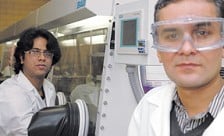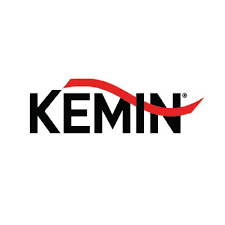More power to you

On a wafer the size of a double-edged razor blade, Sumit Chaudhary has found a way to slice his way to a renewable future.
Chaudhary is part of a team of researchers at Iowa State University and the U.S. Department of Energy’s Ames Laboratory who are searching for an inexpensive way to manufacture solar cells that are more efficient than their predecessors.
In the past, the focus has been on glass or silicon solar cells. Chaudhary, an assistant professor of electrical and computer engineering at ISU and an associate of the Ames Laboratory, leads a team that is investigating organic polymers.
His counterpart on the silicon side of the research is Vikram Dalal, director of ISU’s Microelectronics Research Center, who has spent more than 30 years studying ways to generate electricity from sunlight.
The men have used a nearly $1.7 million Iowa Power Fund grant to build laboratories and carry out their research. They occupy separate rooms at the university’s Applied Sciences Complex.
Chaudhary’s lab is a simple space cluttered with what he calls a “glove box,” where polymer solar cells are produced in a contaminant-free environment.
Solar cells made from flat surfaces, including those made from polymers, are nothing new, Chaudhary said. The problem is that those cells only capture so much light; the rest bounces off the flat surface.
Chaudhary, who has been at ISU since 2007, tapped another old technology in his research by applying a textured surface to the cell. The method had been abandoned because the light-grabbing polymer coating tended to settle in the valleys of the surface, reducing the efficiency of the solar cell.
In addition, some attempts produced a light-absorbing layer with air gaps or a too-thin layer over the ridges or a too-thick layer in the valleys. The result was a loss of charges and short-circuiting at the valleys and ridges.
Two years ago, Chaudhary and his team began looking for a way to apply an even texture of ridges and valleys that were just the right height and pitch to absorb sunlight and reflect any escaping light to the next ridge.
Researches found that by spin-coating the cell, a coating could be produced that remained uniformly thin – even as it traveled up and down ridges that were less than a millionth of a meter high.
Test showed that the polymer solar cells converted 20 percent more energy than their predecessors.
“The implications are humongous,” Chaudhary said, in part because the polymer solar cells are inexpensive to produce.
Iowa State has patented the technology and is looking for manufacturers to mass-produce the polymer solar cells.
For now, uses for the solar cells are somewhat limited.
The problem is that polymers break down after a few years of exposure to moisture and humidity.
That means the polymer solar cells, which can be rolled off presses in large flexible sheets, will not show up on residential rooftops any time soon.
Instead, the practical application for the polymer solar cells is in recharging consumer electronics as well as delivering a short-term pick-me-up for electric cars.
Chaudhary said the solar cells can be installed in window blinds, umbrellas, even bus shelter canopies, where they could be used to recharge cell phones or laptop computers.
He said that in the next few years, homeowners will buy products made up of polymer solar cells the same as they would purchase furniture.
“You’ll see solar cells as widespread as window blinds,” he said.











